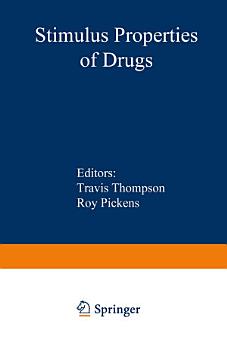Stimulus Properties of Drugs
dic 2012 · Springer Science & Business Media
Libro electrónico
222
Páginas
reportLas calificaciones y opiniones no están verificadas. Más información
Acerca de este libro electrónico
Behavioral pharmacology represents a relatively recent scientific enterprise, the development of which can be followed by plotting the publication of major conceptual papers, review articles, and books. Dews (1955), Sidman (1955), and Brady (1956) published some of the first methodologically significant papers, changing the way both psychologists and pharmacologists viewed the analysis of the behavioral actions of drugs. Dews and Morse (1961), Cook and Kelleher (1963), Gollub and Brady (1965), and Weiss and Laties (1969) kept the field abreast of major developments in the study of behavioral mechanisms of drug action. In 1968, the first textbook in the field was published (Thompson and Schuster), followed by a book of readings covering the preceding 15 years of the field (Thompson, Pickens, and Meisch, 1970). The first attempt to outline a set of generalizations concerning behavioral mechanisms of drug actions was puhlished in 1968 by Kelleher and Morse. As behavioral pharmacology developed, it became clear that demonstrations that drugs affect hehavior were relatively uninteresting. It was the mechanisms by which these effects are hrought about that was of concern. While other aspects of pharmacology have been concerned with biochemical, physiological, and in some cases biophysical accounts of drug actions, behavioral pharmacology has dealt with behavioral mechanisms . . . that is, "any verifiable description of a drug's effects which can he shown to uniquely covary with a specific measured 'response'. Generally, this relation can be subsumed under some more general set of relations or principles" (Thompson, Pickens, and Meisch, 1970, p. I).
Califica este libro electrónico
Cuéntanos lo que piensas.
Información de lectura
Smartphones y tablets
Instala la app de Google Play Libros para Android y iPad/iPhone. Como se sincroniza de manera automática con tu cuenta, te permite leer en línea o sin conexión en cualquier lugar.
Laptops y computadoras
Para escuchar audiolibros adquiridos en Google Play, usa el navegador web de tu computadora.
Lectores electrónicos y otros dispositivos
Para leer en dispositivos de tinta electrónica, como los lectores de libros electrónicos Kobo, deberás descargar un archivo y transferirlo a tu dispositivo. Sigue las instrucciones detalladas que aparecen en el Centro de ayuda para transferir los archivos a lectores de libros electrónicos compatibles.




